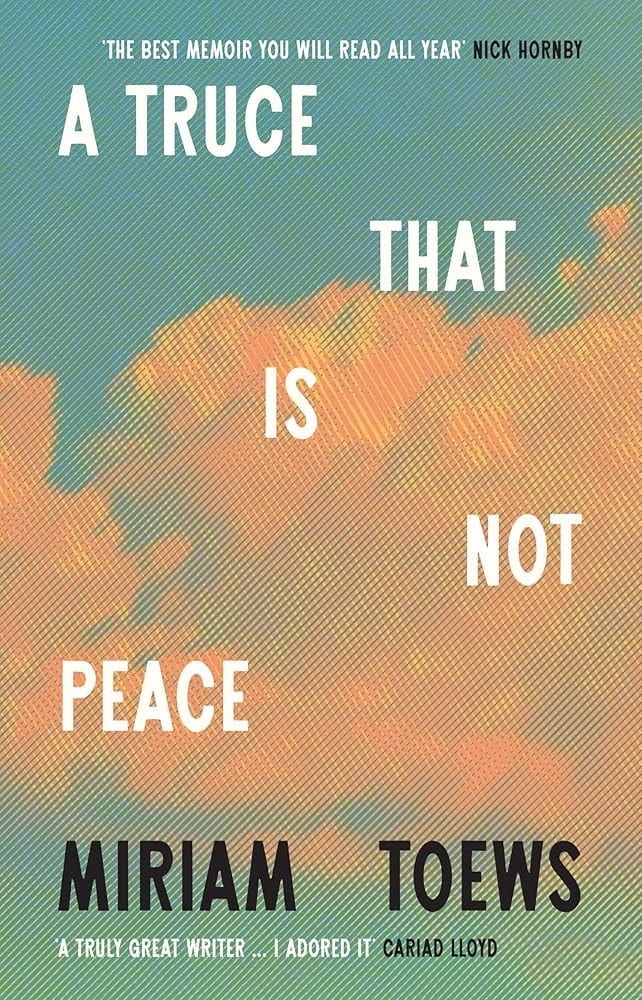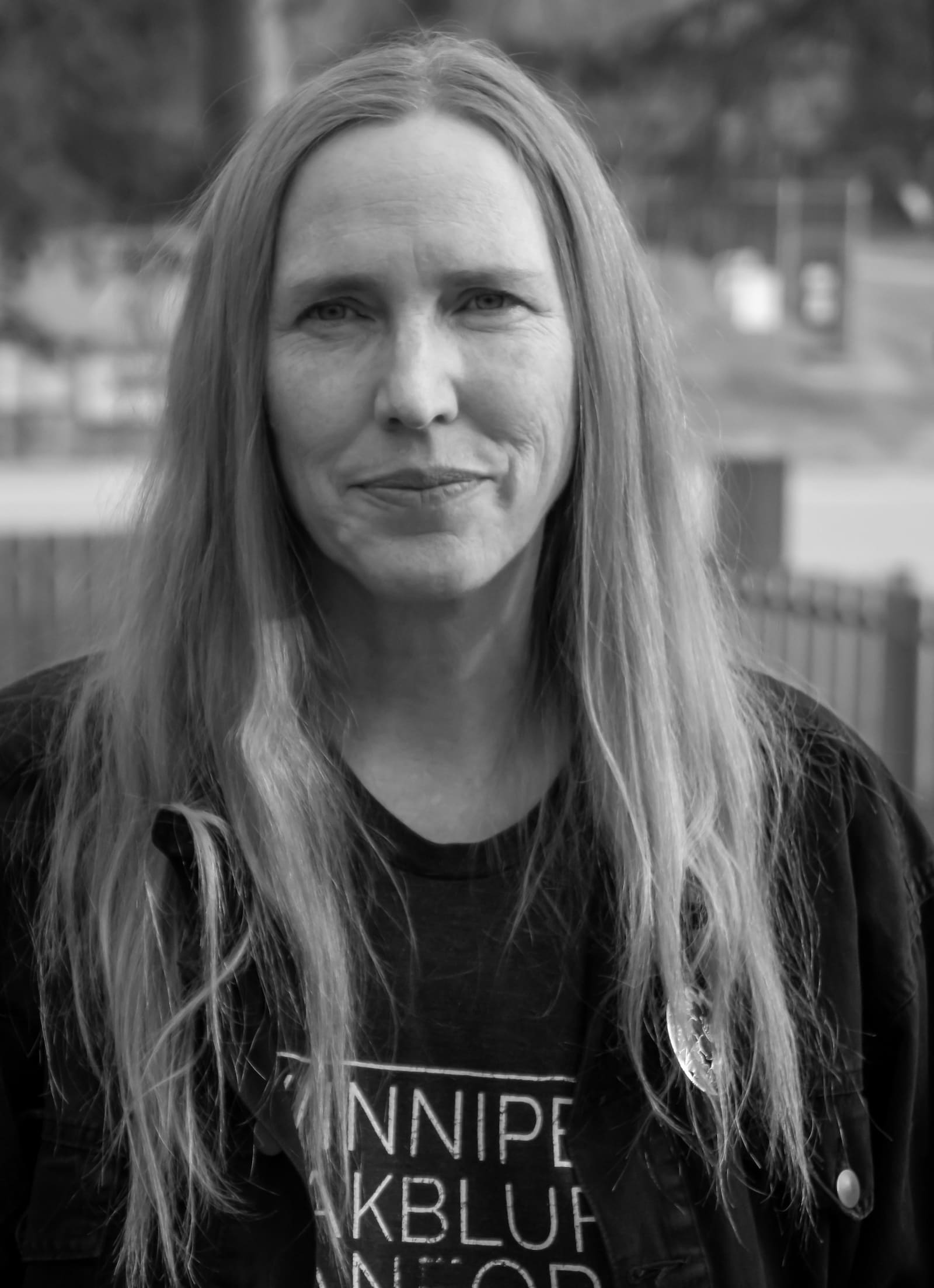Miriam Toews wants to open the world’s first wind museum – a space where one could experience all the different types of gusts, breezes, barbers, and squalls from around the world. In her first memoir, A Truce That Is Not Peace, she compares the desire to harness wind to writing about writing, or answering the deceptively simple question: why write? Writing for Toews is like the wind – ever-present, propelling, able both to comfort and disturb, unruly and ineffable, essential.
As memoirs go, A Truce That Is Not Peace is unconventional – more a series of ongoing questions, anecdotal reflections, and obsessions than a typical autobiographical account, but for a look at Toews’ life, one need only turn to her many landmark works of fiction: A Complicated Kindness (2004) chronicles the coming-of-age of a rebellious Mennonite teen on the Canadian prairies, while All My Puny Sorrows (2014) follows a woman coming to terms with her sister’s and father’s suicides. Most famously, Toews is also the author of Women Talking (2018), based on the mass rape of Mennonite women in Bolivia, and adapted by Sarah Polley into an Academy Award-winning film in 2022.
There are few writers who so fully inhabit the vulnerable space between violence and grace, criticism and compassion, as Toews does. Though clear-eyed about difficult topics, her books are also full of humour and hope, and this reaching for a silver lining – a reason to keep writing or living, which are often mutually sustaining – remains an important undercurrent in A Truce That Is Not Peace. Toews writes, “Between the beginning and the end of civilisation, the Pantheons and the pelting of stones, is the narrow corridor, the spit of land, where writing lives. After disillusion – but just after – and before the end of relief – but quite a bit before – is where writing lives, where the soul (douchebag word, soul? Recently a private equity investor asked me if I thought I had a soul, and I couldn’t stop laughing) of the writer floats, not as in a regatta, sun sparkling on water, but so precariously.”
Here, Miriam Toews speaks with AnOther from her home in Toronto about the precarious act of writing, the genres that shaped her, and literature’s role amid crisis.

Tia Glista: Looking back on your writing life, you include letters written to your sister while cycling through Europe when you were quite young. How has letter-writing shaped your sensibility?
Miriam Toews: It was my sister who said, ‘Send me letters telling me about your trip,’ with the implication that then she would stay alive. That was our pact that was, at the time, seemingly light-hearted. It meant a lot to me, and I think it meant a lot to her too. Obviously, me writing letters isn’t going to be something that would keep her alive; it would be arrogant and foolish to think that. But in my youthful mind, it was a real, urgent thing. Like it was an assignment given to me by her, in a sense. During that letter writing, it did occur to me, ‘Ok, I can write stories,’ like true stories about my life, my adventures, and it felt good to do it. When I think of myself, I still don't think I’m a writer, you know? It’s just something that continued to happen.
TG: Did cultivating a writing practice through letters change the way that you relate to the novel audience?
MT: It’s first person, in an intimate voice. I can see when I look at those letters to my sister that I was experimenting with setting up a scene and dialogue with humour and pathos – all the elements of writing and creating a style that I would continue to use. My last book, Fight Night, was supposed to be this letter written by a nine-year-old kid to her father who’s gone missing. I always wanted to write an epistolary book. I think there’s something about letters, the form and the intimacy of them, that can give permission to be very honest because you can pretend it’s just one person that’s going to see it. Even with this book, A Truce That Is Not Peace, it is, in my mind, a letter to my sister. In a way, all of my books are, or that’s how I need to see them to write them.
“There’s a connection between silence and writing and, I would argue, writing and suicide” – Miriam Toews
TG: I wanted to ask about silence. I’m curious what you make of the idea, as a writer, that there may be some things for which there are no words. Is it the job of the writer to try and find them anyway? Or sometimes to just let silence be silence?
MT: That’s the essence of writing. On the one hand, we might give voice to most of the deep stuff within ourselves, but what about when we can’t shape it into some sort of coherent narrative? I would argue that it’s always a failure; so much of the universe and of what it is to be human is just sort of unsayable stuff. As I get older, I’m more uncertain and less able to find words.
One of the central arguments in the book is, ‘Why bother to write?’ I mention something about how, if my sister‘s silence says more, ultimately, than all the words in the world, or at least the words that I’m using, then why write? I think I was attempting to meet my sister in that place between silence and writing, the white space on the page.
I still don‘t know how to think about it all, but there’s a connection between silence and writing and, I would argue, writing and suicide. Suicide is emphatic; it’s making a statement. It’s life-taking, but, weirdly, it could also be seen as life-giving, if you think of the person who kills themselves as thinking, ‘This is the only way I can essentially save myself.’ Writing is also a way of containing things, of staying alive, of taking all the stuff of life and shaping it into something. These are assertive acts, even the act of silence.
TG: Joan Didion said she wrote to find out what she was thinking. Does that resonate for you?
MT: Definitely. When I start, I don’t know why or what I’m writing, but I have faith in the process. This is something that has changed over my writing life. Now I can give in to that kind of uncertainty a little more. It’s a mysterious process for me. Maybe I need to go through psychoanalysis to figure out why any of us write what we write.
“Writing is a way of containing things, of staying alive, of taking all the stuff of life and shaping it into something” – Miriam Toews
TG: Being open to uncertainty feels different from a lot of the ways that we’re taught to think right now, particularly with AI, which encourages us to bypass the mess of thinking and get to an easy, neat answer.
MT: It’s difficult for us as human beings to accept that grey area. People want answers and endings that make sense to them. For instance, after my dad died – he killed himself, as did my sister later – there were so many people in his hometown who couldn’t get their brains around how this person could have done this and why. I had those same questions – I was obsessed with understanding. I was reading everything, I was trying to get inside his head, and then eventually, you get to a point where you’re just like, ‘Well, I don’t know.’ But that’s difficult to reconcile yourself to.
TG: This book demonstrates profound respect for writing, which you acknowledge can be a kind of fragile thing. What is your hope for literature right now?
MT: Let’s talk about fiction. After 9/11, people liked to say that art was dead, irony was dead, any fabricated interpretation of the world was invalid or frivolous. I disagree with that and I think, more than ever, with the condition of our planet and in this moment politically, to have stories coming from the people who are living through this and experiencing this is more important than ever.
A Truce That Is Not Peace by Miriam Toews is published by 4th Estate and is out now.
